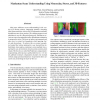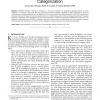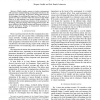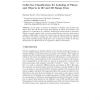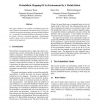168
Voted
WMCSA
2012
IEEE
13 years 8 months ago
2012
IEEE
The rapid growth of location-based applications has spurred extensive research on localization. Nonetheless, indoor localization remains an elusive problem mostly because the accu...
149
click to vote
ICCV
2011
IEEE
14 years 25 days ago
2011
IEEE
This paper addresses scene understanding in the context of a moving camera, integrating semantic reasoning ideas from monocular vision with 3D information available through struct...
135
click to vote
PAMI
2011
14 years 3 months ago
2011
—CENTRIST (CENsus TRansform hISTogram), a new visual descriptor for recognizing topological places or scene categories, is introduced in this paper. We show that place and scene ...
108
click to vote
MCPR2
2011
14 years 3 months ago
2011
We present a strategy that combines color and depth images to detect people in indoor environments. Similarity of image appearance and closeness in 3D position over time yield weig...
ICRA
2010
IEEE
14 years 11 months ago
2010
IEEE
— Mobile wireless sensors in indoor environments will experience multipath fading, causing rapid variations in the capacity of the radio link. We present a strategy that increase...
113
click to vote
RAS
2008
15 years 8 days ago
2008
We present an approach for creating conceptual representations of human-made indoor environments using mobile robots. The concepts refer to spatial and functional properties of ty...
105
click to vote
FLAIRS
2006
15 years 2 months ago
2006
This paper considers a robot with multiple sensors navigating an unknown, heterogeneous environment. In these cases sensor errors may produce an unsuitable model of the world. For...
123
Voted
3DIM
2003
IEEE
15 years 4 months ago
2003
IEEE
Precise digital 3D models of indoor environments are needed in several applications, e.g., facility management, architecture, rescue and inspection robotics. This paper presents a...
189
Voted
GFKL
2007
Springer
15 years 4 months ago
2007
Springer
In this paper, we present an algorithm to identify types of places and objects from 2D and 3D laser range data obtained in indoor environments. Our approach is a combination of a c...
102
click to vote
ICRA
1998
IEEE
15 years 5 months ago
1998
IEEE
This paper addresses the problem of building large-scale maps of indoor environments with mobile robots. It proposes a statisticalapproach that phrases the map buildingproblem as ...

